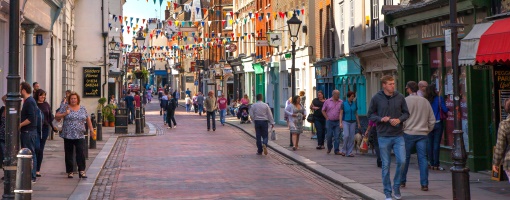A net total of 1,123 stores disappeared from the UK’s top 500 high streets in the first half of this year, as only 1,569 shops opened, compared to 2,692 closures.
Research compiled for PwC by the Local Data Company showed that a combination of growth in online shopping, shift to in-home leisure, heightened restructuring activity and ongoing digitisation of services caused store closures to reach record levels.
The rate of store closures in the first half of 2018 remained at 14 stores a day. However, store openings were down by a third year-on-year.
Closures were most marked in categories affected by online shopping - fashion stores and electricals outlets - and increasing consumer preference for in-home leisure - eating drinking and entertaining at home.
Restaurant, catering and entertainment chains saw a net loss of 340 stores after net rises in the first halves of 2016 and 2017.
Lisa Hooker, consumer markets leader at PwC, said that the continued rate of store closures reflects the new reality that many of us prefer to shop online and increasingly eat, drink and entertain at home.
“Openings simply aren’t replacing the closures at a fast enough rate – specifically, the openings across ‘experiential’ chains, such as ice cream parlours, beauty salons and vape shops haven’t been enough to offset closures in the more traditional categories,” she explained.
“Looking ahead, the turmoil facing the sector is unlikely to abate. Store closures already announced in the second half of the year due to administrations and CVAs [Company Voluntary Agreements] already will further intensify the situation.”
Zelf Hussain, retail restructuring partner at PwC, argued that the transformation of the UK High Street - both physical and virtual - raises questions about how legacy retailers and leisure operators should restructure and what new investment is needed.
“We believe that CVAs can be helpful restructuring tools, but alone are insufficient,” he stated. “Our own research of more than 101,710 companies listed on Company House shows that of the 65 retailers entering into a CVA between 1987 and 2017 more than half failed, leading to another insolvency process.”
In addition to the closures in the retail and leisure sectors, many traditionally store-based service businesses, such as banks, estate agents, recruitment agencies and travel agents, have continued to move online, albeit their rate of closure has slowed as fewer of these types of businesses remain on the High Street.
These four categories accounted for a net 130 store reduction in presence on the UK’s 500 largest high streets in the first half of the year.
Lucy Stainton, senior relationship manager for retail at The Local Data Company, added that the performance of the physical UK retail landscape has passed an inflexion point.
“While there are still many examples of sectors and brands which remain resilient to market challenges, it would be remiss not to acknowledge the increase in store closures, seen especially in the first half of 2018 when the gap between openings and closures has widened significantly.”
Beyond Channels: Redefining retail with Unified Commerce
This Retail Systems fireside chat with Nikki Baird, Vice President, Strategy & Product at Aptos will explore how unified commerce strategies enable retailers to tear down these barriers and unlock new levels of operational agility and customer satisfaction.
The future of self-checkout: Building a system that works for consumers and retailers
In this webinar, industry leaders discussed what the future of self-checkout looks like and how retailers can make the technology work for everyone.
© 2024 Perspective Publishing Privacy & Cookies










Recent Stories